- COVID-19 pandemic led to a sharp decline in global trade, lower commodity prices and tighter external financing conditions with implications for current account balances and currencies of different countries
- India’s forex reserves at an all-time high of US$ 586.1 billion as on January 08, 2021, covering about 18 months worth of imports

- India experiencing a Current Account Surplus along with robust capital inflows leading to a BoP surplus since Q4 of FY 2019-20
- Balance on the capital account is buttressed by robust FDI and FPI inflows:
- Net FDI inflows of US$ 27.5 billion during April-October, 2020: 14.8% higher as compared to first seven months of FY 2019-20
- Net FPI inflows of US$ 28.5 billion during April-December, 2020 as against US$ 12.3 billion in corresponding period of last year
- In H1: FY21, steep contraction in merchandise imports and lower outgo for travel services led to:
- Sharper fall in current payments (by 30.8%) than current receipts (15.1%)
- Current Account Surplus of US$ 34.7 billion (3.1% of GDP)
- Balance on the capital account is buttressed by robust FDI and FPI inflows:
- India to end with an Annual Current Account Surplus after a period of 17 years
- India’s merchandise trade deficit was lower at US$ 57.5 billion in April-December, 2020 as compared to US$ 125.9 billion in the corresponding period last year
- In April-December, 2020, merchandise exports contracted by 15.7% to US$ 200.8 billion from US$ 238.3 billion in April-December, 2019:
- Petroleum, Oil and Lubricants (POL) exports have contributed negatively to export performance during the period under review
- Non-POL exports turned positive and helped in improving export performance in Q3 of 2020-21
- Within Non-POL exports, agriculture & allied products, drugs & pharmaceutical and ores & minerals recorded expansion
- Total merchandise imports declined by (-) 29.1% to US$ 258.3 billion during April-December, 2020 from US$ 364.2 billion during the same period last year:
- Sharp decline in POL imports pulled down the overall import growth
- Imports contracted sharply in Q1 of 2020-21; the pace of contraction eased in subsequent quarters, due to the accelerated positive growth in Gold and Silver imports and narrowing contraction in non-POL, non-Gold & non-Silver imports
- Fertilizers, vegetable oil, drugs & pharmaceuticals and computer hardware & peripherals have contributed positively to the growth of non-POL, non-Gold & non-Silver imports
- Sharp decline in POL imports pulled down the overall import growth
- Trade balance with China and the US improved as imports slowed
- Net services receipts amounting to US$ 41.7 billion remained stable in April-September 2020 as compared with US$ 40.5 billion in corresponding period a year ago.
- Resilience of the services sector was primarily driven by software services, which accounted for 49% of total services exports
- Net private transfer receipts, mainly representing remittances by Indians employed overseas, totaling US$ 35.8 billion in H1: FY21 declined by 6.7% over the corresponding period of previous year
- At end-September 2020, India’s external debt was placed at US$ 556.2 billion – a decrease of US$ 2.0 billion (0.4%) as compared to end-March 2020.

- Improvement in debt vulnerability indicators:
- Ratio of forex reserves to total and short-term debt (original and residual)
- Ratio of short-term debt (original maturity) to the total stock of external debt.
- Debt service ratio (principal repayment plus interest payment) increased to 9.7% as at end-September 2020, compared to 6.5% as at end-March 2020
- Rupee appreciation/depreciation:
- In terms of 6-currency nominal effective exchange rate (NEER) (trade-based weights), Rupee depreciated by 4.1% in December 2020 over March 2020; appreciated by 2.9% in terms of real effective exchange rate (REER)
- In terms of 36-currency NEER (trade-based weights), Rupee depreciated by 2.9% in December 2020 over March 2020; appreciated by 2.2% in terms of REER
- RBI’s interventions in forex markets ensured financial stability and orderly conditions, controlling the volatility and one-sided appreciation of the Rupee
Initiatives undertaken to promote exports:
- Production Linked Incentive (PLI) Scheme
- Remission of Duties and Taxes on Exported Products (RoDTEP)
- Improvement in logistics infrastructure and digital initiatives
Source: PIB & Economic Survey
















